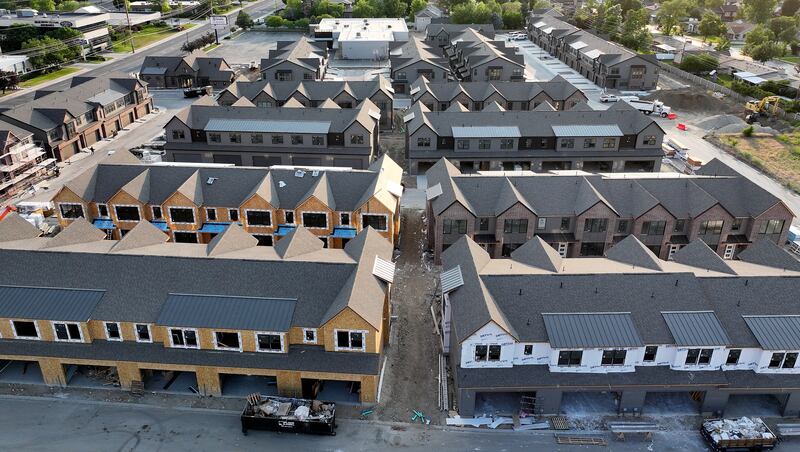Utah Gov. Spencer Cox previewed a “more aggressive” approach to increase the housing supply on Wednesday that could include a statewide zoning preemption to allow for smaller, cheaper units regardless of city ordinances.
The state has increasingly pushed municipalities to approve more, and higher-density, developments as the governor’s office strives to catalyze the construction of 35,000 starter homes amid a persistent housing shortage.
Recent legislative sessions have produced dozens of policy changes that have included limited preemptions where the state has required local governments to approve housing projects around public transit areas and to speed up permitting.
But as Utah continues to see home prices out of reach for more than 90% of non-homeowners, the governor said he plans “to get more aggressive with everything” — even though he would prefer for cities to voluntarily reform their zoning policies to increase housing options.
“Is preemption still on the table? The answer is, yes, it has to be,” Cox told the Deseret News. “I don’t want to go the preemption route, but I would be lying if I said it wasn’t on the table.”
Is deregulation the answer?
Cox was the keynote speaker during the 2025 Ivory Prize Summit held at the University of Utah David Eccles School of Business on Wednesday, which brought together over 100 housing experts from around the country to share innovations in home affordability.
The event, hosted by Ivory Innovations, highlighted the central debate of Utah’s housing crisis: whether local governments need more state support and less micromanagement, or whether the state should bypass local governments to accelerate housing goals.
During an on-stage discussion, Cox said he believed if there were “no government regulations whatsoever” there would be no “housing problem.” And he cited Texas as an example of a state that has taken steps to allow people to build what they want, where they want.
The state’s top home developer, Clark Ivory, told the Deseret News the biggest source of “friction” preventing the production of affordable single-family homes are hurdles at the city level that do nothing to preserve an area’s character.
“Why wouldn’t we remove all of the obstacles that are just regulatory bureaucracy? Why would we go ahead and have unfair standards when they’re not needed?” Ivory asked. “That really is the cost that I think needs to be tackled first.”
Statewide zoning reform could free up municipalities to increase housing options in their community by removing some of the responsibility from local elected officials who face opposition from residents who would rather prevent growth, according to Ivory.
But Utah has long prioritized the value of local control, including over zoning. If the state overrides cities in shaping growth, advocates say Utah communities could lose what makes them unique as developers race to profit from low regulation.
2026 housing priorities
At least one Republican state lawmaker hopes 2026 will be the year the Utah Legislature follows other states in implementing statewide zoning reforms that facilitate smaller lot sizes for single-family houses.
Rep. Ray Ward, R-Bountiful, told the Deseret News he plans to introduce legislation that would create a new zoning default across the state enabling city councils to supersede current ordinances to approve homes on lots that are one-eighth of an acre.
“Utah’s problem has gotten worse quicker than in other states,” Ward said. “It is at least partially because of policy — the amount of requirements and the amount of time that things take to get built is more now than it was in the past.”
Cities would not be forced to approve these developments, according to Ward. But if they opposed such proposals, they would have to take an official vote against it, instead of being able to simply dismiss all requests that don’t match current code.
While some states, like Oregon and Florida, have implemented statewide preemptions to streamline zoning, this approach is unlikely to gain traction in Utah, according to the governor’s senior adviser for housing strategy and innovation, Steve Waldrip.
“There’s a pretty strong group of legislators that are focused on local control as the primary method of all zoning,” Waldrip told the Deseret News. “And to this point, the Legislature hasn’t been willing to entertain upsetting that balance.”
Instead, Cox’s administration has opted to create incentives for municipalities and developers to permit single-family “starter homes,” through an infrastructure bank and low-interest financing options backed by state reserves.
An instance of preemption that has worked well in Utah are initiatives that require communities to boost housing availability around public transit stops, Waldrip said, which are responsible for the planning of over 93,000 housing units, according to a state report.
On Oct. 15, Waldrip presented the administration’s new Statewide Strategic Housing Plan, which had been requested by legislators following a November 2023 audit that found the state lacked a cohesive strategy to get municipalities on board with changes.
The plan lays out 46 policy proposals, with five top tactics. These include:
-
Identifying state-owned land like old school properties for future housing.
-
Expanding low-interest loan funds for infrastructure and construction to be repaid by the development.
-
Providing resources to train rural governments to streamline housing development processes.
-
Prioritizing state funding programs for cities that are implementing state housing priorities.
Cox said he has yet to discuss details about the upcoming session with legislative leadership. He has scheduled a meeting with them this week to begin brainstorming. But he said it “would be fair to say that implementation of that plan is going to be a top priority.”
Pushback on preemptions
Some Utah residents see the state’s approach on housing as heavy-handed, and out of step with free-market principles. Utah County Republican Party Chair Cristy Henshaw also questioned the underlying data informing Cox’s approach.
Utah Department of Workforce Services data shows the state’s population increasing at a slower rate than past years, Henshaw pointed out, with the exception of international migration, which made up more than half of the growth in 2023 and 2024.
Other data suggests that home prices are driven by economic factors outside of the state’s hands that can’t be resolved through “a centrally-planned housing market,” Henshaw said, referring to state efforts to manipulate incentives for home builders.
Even as housing inventory reaches a 10-year high, the median listed home price has remained stubbornly around $600,000. High interest rates and inflation won’t be fixed by the Legislature exerting pressure on cities, Henshaw said.
“They need to go back to the drawing board and ask the better questions to see what they’re getting ‘mandated’ by holding on to the funding purse strings against the municipalities,” Henshaw said.
Mike Carey, the chair of the Salt Lake County GOP, agreed, saying that the growth coming to Utah is natural and that the housing industry is responding by introducing a record number of homes into the market for sale.
Carey, a construction executive from the East Coast, said the state risks overreacting to a temporary economic environment in a way that negatively impacts residents’ quality of life for years to come.
“Riverton or Sandy or Cottonwood Heights, if I live in any one of those towns, I typically didn’t move there because I wanted it to be a city one day,” Carey said. “The second you densify, you’re just adding more people into a system that’s already kind of at capacity.”
‘Supply, supply, supply’
From the governor’s point of view, while the cause of Utah’s housing crisis may be complex, the solution is simple: “supply, supply, supply,” as Cox told attendees at Wednesday’s conference.
The University of Utah’s Kem C. Gardner Institute has forecast that, over the next 10 years, the state will fall 50,000 housing units short of meeting demand. This has contributed to a median housing price that remains over five times the area median income, Waldrip said.
This ratio, which fits into the category of extremely unaffordable, has created a housing market where only 9% of non-homeowners can afford the median-priced home. But there are signs the state’s approach is beginning to work, according to Waldrip.
Over the past year, Salt Lake City’s rental stock increased by more than 8,000 units, the largest volume in at least 15 years, according to a Yardi Matrix report. And this glut of new units was accompanied by a 1.2% decrease in average rates.
There are three things every state should do that will naturally unlock this supply, according to Alli Quinlan, the acting director of Incremental Development Alliance, which advocates for policies that enable communities to bring back a variety of housing options.
Quinlan, who spoke at Wednesday’s event, advocates for states to pursue statewide preemptions that prohibit minimum lot widths and minimum lot sizes, and to implement “administrative platting,” which allows cities to divide property into smaller lots without a public hearing.
These changes may sound dramatic, but in practice they would allow for the same level of flexibility that existed before a push in the 1960s for uniform zoning laws, Quinlan said, arguing that removing strict zoning restrictions actually lets towns build more of what made them unique in the first place.
“We’re not saying, ‘Make people do this’; we’re just saying, ‘Let people do this,’” Quinlan told the Deseret News. “Remove the government regulations that prevent people from doing this very practical, very common, very historical way that we used to build towns.’
For the Cox administration, the stakes couldn’t be any higher. Home ownership gets at the heart of family formation and generational wealth, according to Waldrip. Cox said he hired Waldrip not to advise on pro-growth policies, but to “save the American dream in Utah.”
The major problems facing the U.S. are downstream from home ownership, according to Cox. And if Utah loses its status as the No. 1 state in the nation it will be because residents’ children and grandchildren lost the ability to afford a home here, Cox said.
“Home ownership is core to the American dream — I think they are one in the same,” Cox said at the conclusion of his remarks. “It’s the most important thing we can do, and we have to revive the American dream.”









